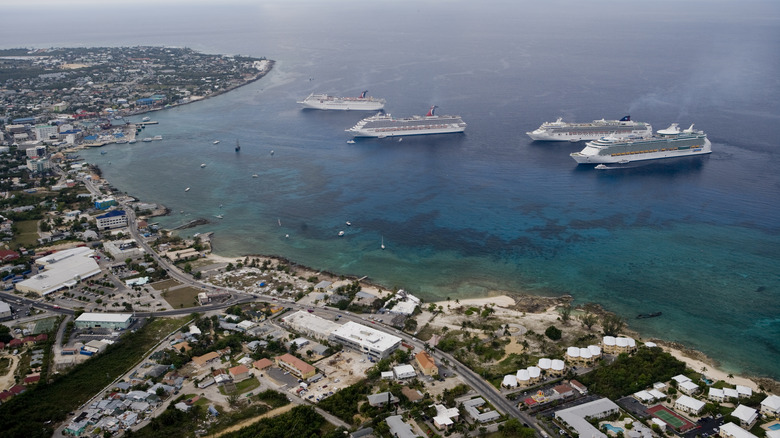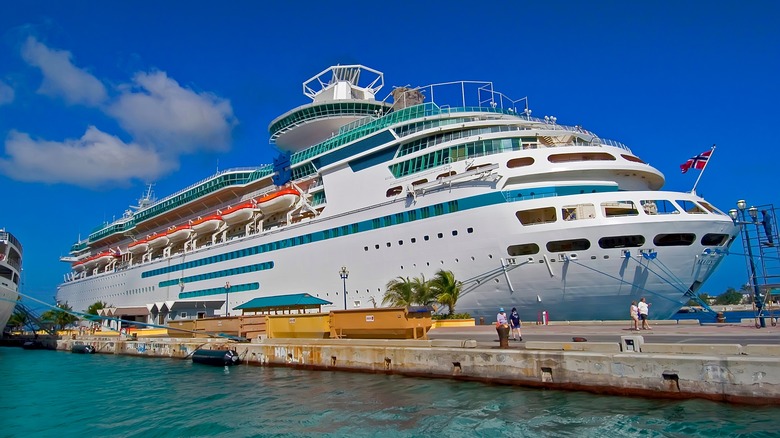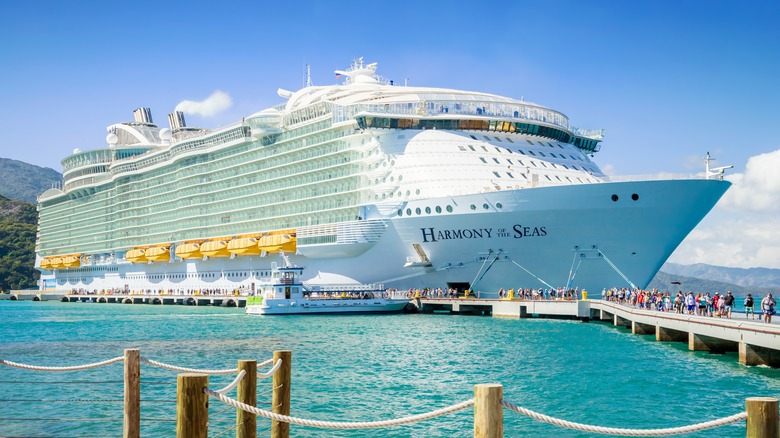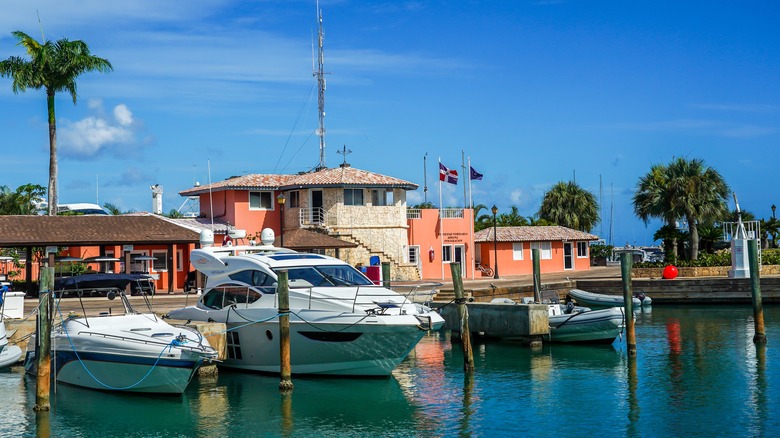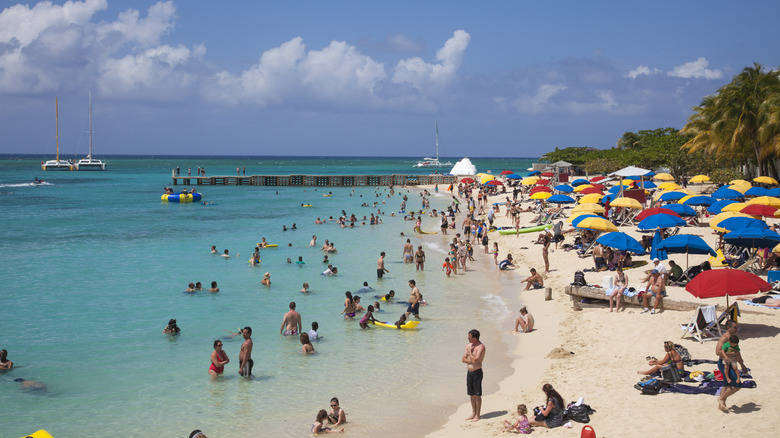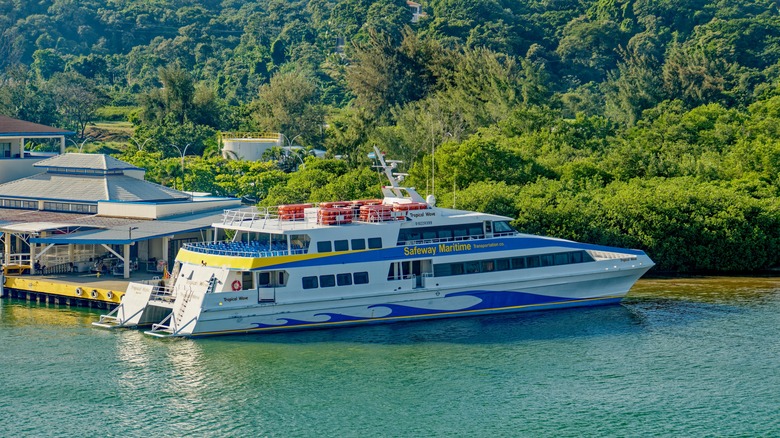Avoid The Caribbean's Most Dangerous Cruise Ports
One of the perks of going on a cruise is the chance to explore distant countries. That's especially true in the fiercely popular Caribbean region, which receives 40% of worldwide cruise passengers each year, per Statista. Although this region is a hoppin' spot, not all locations are created equal, and there are still several dangerous Caribbean destinations you might want to avoid. From a cruise ship perspective, a few of the region's ports raise more concerns than others.
If your cruise stops at one of these spots, you have options for keeping yourself safe without missing out. For example, you should consider only booking shore excursions through your cruise line. "We've vetted them out, we know they're insured, we go through the inspections and we know they're licensed," a Royal Caribbean, Celebrity and Azamara spokesperson informed Cruise Critic while discussing tour operators. "We have all of that in check before we send anyone on a tour." You can also avoid trouble by traveling in a group.
Bear in mind that you don't have to disembark; if your cruise stops at one of these precarious ports of call, you can stay onboard. Save those long exploration days for safer, stress-free Caribbean islands or simply enjoy the less crowded ship. If you do decide to head out to a port with a dodgy reputation, first familiarize yourself with the known dangers of each location to mitigate your risk.
The Bahamas
The presence of The Bahamas on this list may surprise some folks. After all, the country is the most frequented cruise destination in the Caribbean. In 2022, The Bahamas received around 5.4 million cruise arrivals (according to Statista), nearly double the second-highest destination. However, that doesn't negate the dangers that lurk throughout the islands.
In early 2024, the U.S. State Department raised the travel advisory for the country to Level 2: Exercise Increased Caution, identifying the main areas of concern as New Providence (Nassau) and Grand Bahama (Freeport). The change in level occurred due to an increase in gang violence, murders, robberies, and other violent crimes — by the end of January, the country had already seen 18 murders. To increase your chances of staying safe, the State Department suggests not resisting robbery attempts or answering the door for strangers. In addition, it warns travelers that many water activities lack proper regulation or certification, and thus, they should approach them with caution.
On top of human-induced danger, sharks are also a factor, with the archipelago home to the most dangerous, shark-infested beach in the Caribbean. The country also has one of the highest shark attack rates on the planet, according to the International Shark Attack File. Since 2012, the organization reports that five non-fatal shark attacks have occurred in The Bahamas, with a grand total of 33 unprovoked attacks in recorded history — the highest in the region.
Labadee, Haiti
Cruise lines own several private islands in the Caribbean, including Labadee, Haiti. Technically, the Royal Caribbean-owned area is a peninsula and not an island, but even as a privately managed space, decades of instability have made Haiti too dangerous for ships to visit. Royal Caribbean will not stop in Labadee until at least September 2024. The State Department has listed Haiti as Level 4: Do Not Travel — the worst rating. The country received this designation due to widespread kidnapping, civil unrest, violent crime, and lack of healthcare infrastructure. The department also warns that kidnapping "regularly includes U.S. citizens."
María Isabel Salvador, Special Representative of the Secretary-General and Head of the United Nations Integrated Office in Haiti (BINUH), said during an April 2024 UN meeting, "Some of the worst scenarios for Haiti have become realities in recent months and weeks." On top of these fears, Haiti poses a health threat. According to the CDC, Cholera has been an issue since the 2010 earthquake, though instances have declined. Most of the U.S. cholera cases between 2007–2017 cropped up after American travelers returned from Haiti, Cuba, and the Dominican Republic. While no United States cholera cases in 2018 or 2019 were linked to visits to Haiti, the CDC still describes transmission as "widespread" in the country. It poses a minimal risk to travelers; however, you should still monitor what you consume during your visit and wash your hands regularly.
Dominican Republic
Similar to The Bahamas, the Dominican Republic has received a Level 2: Exercise Increased Caution rating from the State Department. The dangers in the country stem from higher rates of violent crime, drug trafficking, issues with weapon control, and a general lack of criminal justice infrastructure. However, the State Department suggests tourist areas receive better policing than other parts of the country because of the implementation of a "tourist police corps."
Canada also lists the Dominican Republic at its second-highest threat level for violent crime and petty theft. On top of that, the Canadian Government explains that scams run rampant there. From fake cops and exploitative lawyers to sketchy ATMs, visitors must look out for lots of fraudsters. These crimes happen day or night, so the officials recommend that travelers remain vigilant — no matter the time of day or location. The Canadian Government also has specific guidance for female travelers, given the reported assaults in the country. "Incidents of assault, rape and sexual aggression against foreigners have occurred, including at beach resorts. In some cases, hotel employees have been implicated," states the advisory.
Jamaica
Jamaica, one of the most famous Caribbean islands, has had a Level 3: Reconsider Travel threat since 2022. Per the State Department, travelers should avoid this country because of increased crime and lack of adequate medical and emergency services. In some cases, the loved ones of U.S. citizens killed in the country have had to wait over a year for a death certificate. Jamaica has also had one of the highest homicide rates in the Western Hemisphere for years, the department highlights. Adding to the concerns, several areas within Jamaica have separate Do Not Travel listings for U.S. government personnel due to violence, including port cities like Montego Bay and Kingston. Although not directed at tourists, the recommendation is worth keeping in mind.
Safety advice from the Canadian Government gets more specific, warning LGBTQIA+ travelers that the Jamaican legislature does not support the community. "Jamaican law prohibits sexual acts between individuals of the same sex," the warning notes. "Other related offences include being in a same-sex marriage and the 'promotion of homosexuality.' Those convicted can face sentences of up to 10 years in prison, though authorities rarely enforce the law." Due to the severity of the situation, some have called Jamaica the "most hostile" place in the Caribbean for the LGBTQIA+ community.
Roatán, Honduras
The island of Roatán in Honduras is considered part of the Western Caribbean. Although the Bay Islands are known to be safer than the mainland, they still have their dangers. As part of that island grouping, Roatán is a port city known for scams, which is why the Canadian Government suggests only booking excursions "through a reputable company."
The State Department lists Honduras as having a Level 3: Reconsider Travel threat. The department cites violent crime, kidnapping, and human trafficking as some of the main reasons for the rating. Additionally, the Government of the United Kingdom states that petty theft is a concern for visitors to Roatán. It advises travelers to remain aware of their belongings in any public space and to be wary of ATMs due to the frequency of robberies and skimming.
Travelers going to Honduras also need to be mindful of potential exposure to dengue fever. According to the CDC, outbreaks of dengue occur every few years, with the disease transmitted through mosquito bites. Honduras is one of the 32 countries known for having the illness, which can occur year-round. If contracted, the illness can take two weeks to show symptoms that can be mild or, in severe cases, lead to death.
